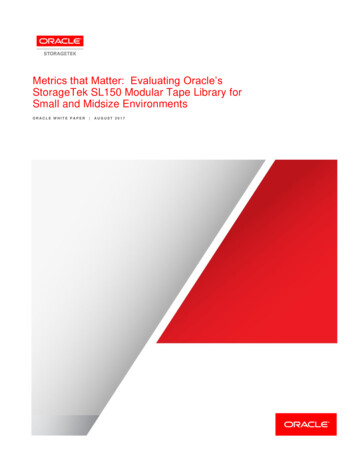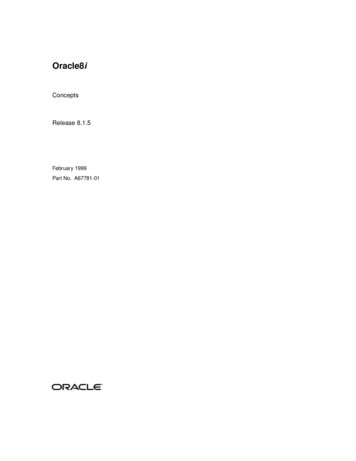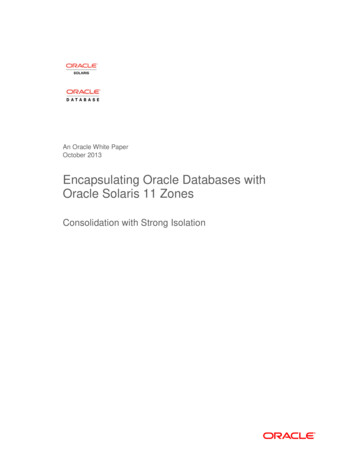
Transcription
Metrics that Matter: Evaluating Oracle’sStorageTek SL150 Modular Tape Library forSmall and Midsize EnvironmentsORACLE WHITE PAPER AUGUST 2017
Table of ContentsIntroduction2Oracle’s StorageTek SL150 Modular Tape Library3Installing, Servicing, and Upgrading the StorageTek SL1503An Electric Argument: Power Consumption Differences3Price vs. Performance Comparison4Converting Cost Savings into Smaller Backup Windows6The StorageTek SL150: The Best Value for Small and Midsize Environments61 METRICS THAT MATTER: EVALUATING ORACLES STORAGETEK SL150 MODULAR TAPE LIBRARY FOR SMALL AND MIDSIZE ENVIRONMENTS
IntroductionStorage environments that utilize tape libraries with fewer than 500 slots have different requirementsthan large data centers. While large data centers rely heavily on high availability and performancemetrics, small and midsize businesses tend to have lighter workloads so performance becomes lesscritical. Additionally, the nature of these workloads often makes the advanced storage featurescommon in enterprise environments irrelevant.Although performance characteristics still do matter to a lesser degree, the most critical metrics fortape libraries in small and midsize businesses are time and money. These companies look for savingsin terms of product purchase and maintenance cost, as well as the time needed to install, upgrade, ormanage a library. Keeping these interests in mind, Oracle developed the StorageTek SL150 modulartape library.2 METRICS THAT MATTER: EVALUATING ORACLES STORAGETEK SL150 MODULAR TAPE LIBRARY FOR SMALL AND MIDSIZE ENVIRONMENTS
Oracle’s StorageTek SL150 Modular Tape LibraryFor years, the entry-level tape library market has been dominated by one manufacturer of a 24-slot library and a 48slot library. Over the years, many companies, including Oracle, have sold the libraries. Oracle sold them as Oracle’sStorageTek SL24 tape autoloader and Oracle’s StorageTek SL48 tape library. The same vendor has alsomanufactured the HP MSL2024/MSL2048, the IBM TS3100/TS3200, and Dell TL2000/TL4000. Oracle’s customersspoke out about the need for a scalable library that they could install, upgrade, and manage themselves; and, inmid-2012, Oracle launched the StorageTek SL150 modular tape library as an alternative to these libraries. TheSL150 modular tape library supports half-height (HH) LTO-5 and LTO-6 drives in interface options of Fibre Channel(FC) or Serial Attached SCSI (SAS). The StorageTek SL150 base configuration has 30 slots and one half-heightStorageTek LTO drive from Oracle. It can scale as the customer’s data and performance needs increase, up to atotal of 450 slots (in 30-slot increments) and 30 drives.Installing, Servicing, and Upgrading the StorageTek SL150All of the libraries that cater to small and midsize environments offer customer installation as a core requirement.However, with the StorageTek SL150, Oracle has taken serviceability to the next level. Now, most serviceoperations can be performed by the customer, preventing downtime caused by waiting for service personnel forsimple issues.Of course, service operations should be relatively rare given that the StorageTek SL150 is produced by Oracle, theleader in tape automation reliability. A far more likely event will be upgrading the library to support more capacity byadding additional slots. With 24- and 48-slot libraries, this means installing a whole new library; either by addinganother new library to the environment or tearing out the small one and replacing it with a larger one. In the past, ifcustomers required more than 48 slots, they moved to a scalable library such as Oracle’s StorageTek SL500modular library system or the Quantum i500. Installation, upgrades, and management of this type of library isgenerally not as simple, and often requires a high level of tape automation knowledge or service personnelassistance. For example, adding expansion modules to traditional scalable libraries can take as long as six hours tocomplete. In contrast, a customer can add a new expansion module (30 slots) to the StorageTek SL150 in justminutes.An Electric Argument: Power Consumption DifferencesTape storage is already well known as a green technology, but the StorageTek SL150 provides additional savingscompared to other libraries in small and midsize environments. A StorageTek SL150 with four half-height LTOdrives, redundant power supplies, and 60 slots is relatively comparable to the StorageTek SL48 and the QuantumScalar i80 tape libraries. In an idle state, the StorageTek SL150 will use about 78 watts of power. By comparison, a48-slot library, such as the StorageTek SL48 tape library, uses 312 watts in the same maximum steady statescenario, a difference of 149 watts. Idle conditions should produce similar differences.The StorageTek SL150 also beats Quantum’s i40 and i80, which expect typical power consumption to be 200watts1. If the StorageTek SL150 is used in an environment with four hours of a maximum steady state condition(such as a backup window), and is idle the rest of the day, then its power consumption averages out to just 92 wattsper hour. That adds up to 108 watts per hour savings with the StorageTek SL150.1Quantum Scalar i40/i80 User’s Guide: 6-66545-09 Rev A3 METRICS THAT MATTER: EVALUATING ORACLES STORAGETEK SL150 MODULAR TAPE LIBRARY FOR SMALL AND MIDSIZE ENVIRONMENTS
What do these power savings really mean? A leading gas and electric company charges almost .18/kWh for smalland midsize commercial business environments2. The one-year savings and inflation-adjusted five-year savingsusing a StorageTek SL150 is shown in Table 13. Ultimately, using a StorageTek SL150 could save a user morethan 1,800 over this time period. To put it in perspective, that’s enough to pay for an expansion module and a 20pack of LTO media!TABLE 1: POWER COSTS OF STORAGETEK SL150 AND COMPARABLE LIBRARIES RUNNING A FOUR-HOUR PER DAYBACKUP JOB AND IDLE FOR TWENTY HOURSTape LibraryTypical PowerConsumptionAnnual Power CostAdditional PowerAdditional CostCostOver Five YearsStorageTek SL15092 watts/hour 147.64------Quantum Scalar i80200 watts/hour 320.37 178.07 1,364.48StorageTek SL48250 watts/hour 399.66 257.36 1,972.05Price vs. Performance ComparisonWhile performance is arguably always important, the priorities of smaller businesses indicate that performance is notreally a critical consideration. Since performance is historically a checklist datasheet component, it is often quoted asa potential differentiator by various vendors. However, the best way to compare tape libraries is through a metriccommonly referred to as exchanges per hour (EPH). What becomes more important for small businesses, relative tothis metric, is to compare EPH between libraries relative to their prices.To illustrate this difference, similar configurations for different libraries were set up and tested. The baseconfiguration of the StorageTek SL150 with 30 slots was used to compare with the StorageTek SL24 tapeautoloader’s full configuration. Each library was configured with two half-height LTO Fibre Channel drives. A similarconfiguration was tested with the StorageTek SL48 tape library, but with double the number of slots and drives. Theperformance tests first measured the drive mount time, meaning the time from when a tape cartridge is moved fromits slot until it is fully loaded in a drive.Drive dismount time was also tested. This is the time required to move a tape cartridge out of a drive and back to aslot in the library. Both “data path” dismounts and “forced” dismounts were tested. Drive “data path” dismounts areinitiated by a host application, while “forced” dismounts are when the tape cartridge must first be unloaded from thedrive by the library before it is moved to a slot. The dismounts are initiated from the beginning of the tape, though nofiles are read or written since the purpose is to measure library performance instead of drive performance. Fromthese metrics, EPH can be determined. This is the most critical metric in measuring library performance as all othermetrics are somewhat dependent on the tape drives or file sizes. The test results for the StorageTek SL150 modulartape library with the latest firmware version, the StorageTek SL24 tape autoloader and the StorageTek SL48 tapelibrary are shown on the next page in Table 2.2PG&E, A-10 Electric Rates for May 2014 - Present. ALThe Typical Power Consumption formula for the StorageTek SL48 is the same as described for the StorageTek SL150. The inflationadjusted savings assumes an annual 3% electricity rate increase.34 METRICS THAT MATTER: EVALUATING ORACLES STORAGETEK SL150 MODULAR TAPE LIBRARY FOR SMALL AND MIDSIZE ENVIRONMENTS
TABLE 2: STORAGETEK SL150, STORAGETEK SL24 AND STORAGETEK SL48 LIBRARIES EXCHANGES PER HOUR WITHLIST PRICEExchanges per Hour withExchanges per Hour with“Data Path” Dismounts“Forced” DismountsStorageTek SL150 base modulewith 2 LTO Drives53 ex/hr42 ex/hr 12,585StorageTek SL24 with 2 LTODrives38 ex/hr33 ex/hr 19,850StorageTek SL150 base moduleand 1 expansion module with 4LTO Drives51 ex/hr39 ex/hr 26,570StorageTek SL48 with 4 LTODrives37 ex/hr31 ex/hr 43,250Tape LibraryList PriceThe SL150 performance numbers are on average 33% better than that of the SL24 and SL48. The SL150 providesbetter performance than the StorageTek SL24 at 37% less list price. In the larger environment the SL150exchanges per hour are on average 32% greater than the SL48 at 39%less list price. The customer of the SL150 receives more benefits at alower cost when compared to either the SL24 or SL48. When examined inthis way, for smaller businesses, 24-slot or 48-slot libraries are an expensethat would be tough to justify compared to the StorageTek SL150. TheStorageTek SL150 has an additional benefit of having more slots in itsbase configuration. Further, the StorageTek SL150’s maximumconfiguration is 300 slots, far more than the 45-slot limit of the 48-slotlibraries, so there is room for customers to grow their tape environmentover time as their data storage needs increase.Forward-looking customers may recognize that this scalability is similar tothe StorageTek SL500, which also starts at just 30 slots. Similarperformance tests were also done with the StorageTek SL500, and again,the same configuration was used with two LTO tape drives. TheStorageTek SL500 has enterprise-class components and was designed formore demanding environments, and by design the StorageTek SL150’sperformance is lower. However, for less demanding environments, theStorageTek SL150 offers a much more attractive performance-to-priceratio. For one third of the price, the StorageTek SL150 can produce half ofthe StorageTek SL500’s performance (under certain use cases).Figure 1. Oracle’s StorageTek SL150modular tape libraryEssentially, for every additional exchange per hour beyond what theStorageTek SL150 already provides, the customer must pay an additional 1170 for the StorageTek SL500. Mostgrowing businesses would not consider that an ideal investment.5 METRICS THAT MATTER: EVALUATING ORACLES STORAGETEK SL150 MODULAR TAPE LIBRARY FOR SMALL AND MIDSIZE ENVIRONMENTS
Converting Cost Savings into Smaller Backup WindowsThere are two different strategies for utilizing the cost savings of the StorageTek SL150. Customers could simplypocket the savings, or they could use the savings to purchase additional components (such as drives, powersupplies, or expansion modules) for the library.Reducing backup windows is often a critical concern for small businesses where backups can’t be madecontinuously. This is one way to consume the cost savings offered by the StorageTek SL150. By utilizing thesavings to purchase additional drives, and therefore reducing the backup window of a business, the customerconverts the cost savings into time savings.To keep up with unprecedented data growth in all sizes of businesses, another option to take advantage of thesavings offered by the StorageTek SL150 would be to purchase additional capacity (expansion modules; eachmodule with LTO-7 stores 180TB of uncompressed data (max of 2.7 PB)). With no need to rip and replace to addmore capacity, the customer, within minutes, can add an additional 30 slots (or more, up to 14 additional expansionmodules) to a library. The StorageTek SL150 allows for higher density with both drives and cartridges thancomparable tape libraries such as the Quantum i40/i80 libraries as shown in Table 3.TABLE 3: STORAGETEK SL150 AND QUANTUM I40/I80 DENSITIES WITH LTO-5, LTO-6, AND LTO-7 FC DRIVESStorageTek SL150Quantum I40/I801,125 TB in 31Ui40: 125 TB in 3UMaximum Density – CapacityLTO-6 FCi80: 250 TB in 6ULTO-7 FC2,700 TB in 31Ui40: 300 TB in 3Ui80: 600 TB in 6UMaximum Density – Drives30 drives in 31Ui40: 2 in 3Ui80: 5 in 6UThe StorageTek SL150: The Best Value for Small and Midsize EnvironmentsWhether a customer wants a simple tape library for backup and compliance or has visions of growing a tapeenvironment to support archive initiatives, the StorageTek SL150 clearly provides value, whether using cost-basedor time-based metrics. It represents about a 38%savings over 24-slot and 48-slot libraries, while also providing amore reasonable price point for performance among customers who might have previously considered a scalablesolution such as the StorageTek SL500. It is easy to see how the StorageTek SL150 delivers an unprecedentedvalue to small and mid-size customers looking for a scalable tape solution when considering these advantages, aswell as the cost saving advances in terms of footprint, infrastructure requirements, and ease of use.6 METRICS THAT MATTER: EVALUATING ORACLES STORAGETEK SL150 MODULAR TAPE LIBRARY FOR SMALL AND MIDSIZE ENVIRONMENTS
Oracle Corporation, World HeadquartersWorldwide Inquiries500 Oracle ParkwayPhone: 1.650.506.7000Redwood Shores, CA 94065, USAFax: 1.650.506.7200CONNECT W ITH ht 2017, Oracle and/or its affiliates. All rights reserved. This document is provided for information purposes only, and thecontents hereof are subject to change without notice. This document is not warranted to be error-free, nor subject to any otherwarranties or conditions, whether expressed orally or implied in law, including implied warranties and conditions of merchantability orfitness for a particular purpose. We specifically disclaim any liability with respect to this document, and no contractual obligations areformed either directly or indirectly by this document. This document may not be reproduced or transmitted in any form or by any means,electronic or mechanical, for any purpose, without our prior written permission.oracle.comOracle and Java are registered trademarks of Oracle and/or its affiliates. Other names may be trademarks of their respective owners.facebook.com/oracleIntel and Intel Xeon are trademarks or registered trademarks of Intel Corporation. All SPARC trademarks are used under license andare trademarks or registered trademarks of SPARC International, Inc. AMD, Opteron, the AMD logo, and the AMD Opteron logo aretrademarks or registered trademarks of Advanced Micro Devices. UNIX is a registered trademark of The Open Group. 0817
LIST PRICE Tape Library Exchanges per Hour with "Data Path" Dismounts Exchanges per Hour with "Forced" Dismounts List Price StorageTek SL150 base module with 2 LTO Drives 53 ex/hr 42 ex/hr 12,585 StorageTek SL24 with 2 LTO Drives 38 ex/hr 33 ex/hr 19,850 StorageTek SL150 base module and 1 expansion module with 4 LTO Drives











